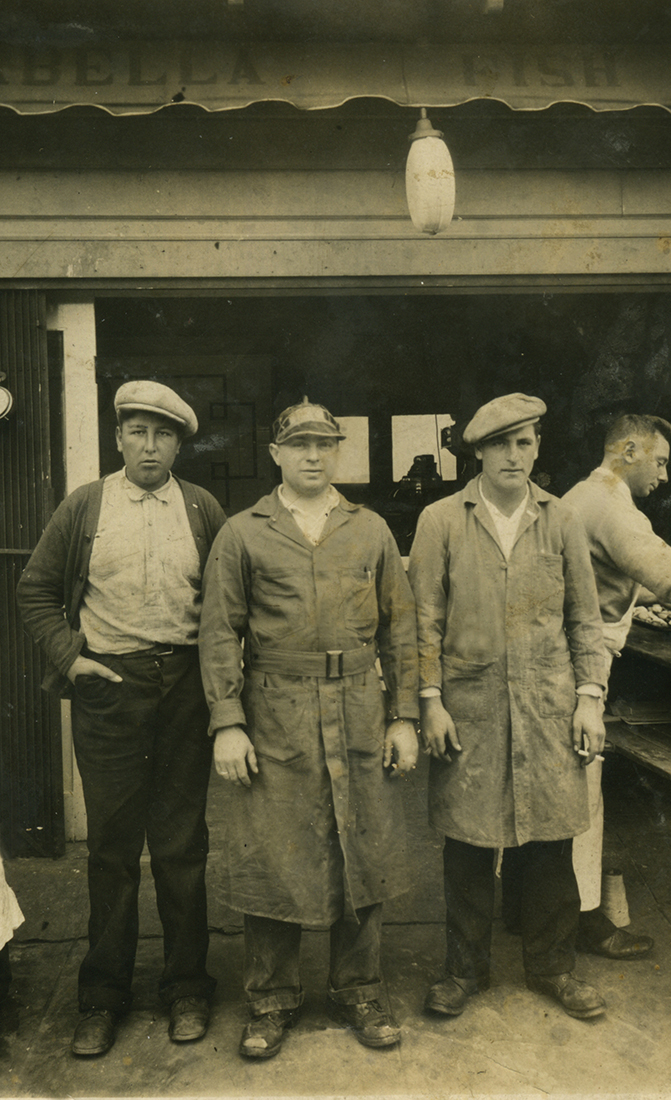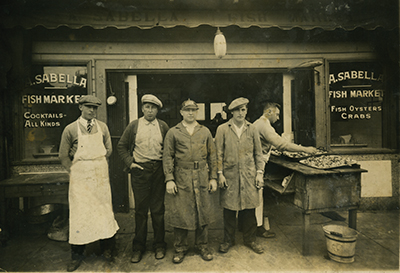
(left to right): Frank Sabella, “Nege Fo” LaRocca, Angelo Sabella, Carlo Rafello and Antone Sabella at work in 1929..
MANY FAMILY BUSINESS founders envision passing their enterprise on to their children and grandchildren — but that dream doesn’t play out for most.
Only a third of family businesses outlive the founding generation, and just over one in 10 will be taken over by the grandchildren. Beyond that? The pool of survivors shrinks to 3 percent, according to Raleigh, N.C.’s Family Business Institute.
To move forward together, multiple generations must share a common vision, and they can’t forget the “business” in “family business,” says Wayne Rivers, president and co-founder of the institute. Families will naturally do what they can to keep everyone happy so that they can sit down together at Christmas, Rivers says, but “they still have to make decisions about the business." He warns that many family companies falter because they lack decision-making protocols.
What is needed to operate a business that your grandchildren can carry forth? We talked to five families with businesses or roots in Marin about how they have kept Mom and Pop’s or Grandma and Grandpa’s enterprise flourishing over the years.
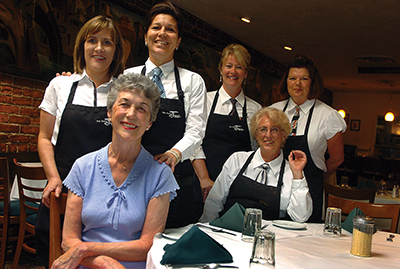
Courtesy of the Marin Independent Journal
The experienced San Rafael Joe’s waitress team (as seen in 2007) loves the continuity of working for one family.
San Rafael Joe's
Generations: 3
Cynthia Farina can understand why so many family businesses fizzle after one generation. For one thing, it’s just harder to run some types of business nowadays than it was in 1947, when her parents, Guido and Theresa Farina, her Uncle Hector Rubini and her Aunt Nancy Rubini opened San Rafael Joe’s.
“My father has said, ‘If I had to open the doors today and run it the way you kids have to, I couldn’t do it,’ ” Cynthia says. Instead of dealing with health inspections and workers’ comp, in those days, “you got a license to open the business, you got a liquor license if you could — and you opened the doors.”
Cynthia, brother Carlo Farina and cousin Chez Bornia joined Guido and Theresa when the Rubinis retired in 1981. The team faced its biggest test in 2000, when the dire need for a makeover forced them to a decision point.
“We had to decide, are we going to do this major remodel, or should we call it a day and sell the business? All of us were on the fence,” Cynthia recalls. They worried that customers — many who have been coming to the restaurant for generations themselves — would be turned off by the construction or by the new look.
Cynthia agrees with consultant Rivers: making decisions with family members can be tense. But in the end their shared experiences — like memories of busing tables while your seventh-grade classmates are eating in the dining room — guided them to consensus.
“The fact that we all cared about each other so much and knew we weren’t ready to say good-bye to the place, that’s why we pushed forward on that,” Cynthia says. Customers embraced the makeover, and today the restaurant that started with just 70 seats can serve more than 200 guests at a time and has a banquet room for 100.
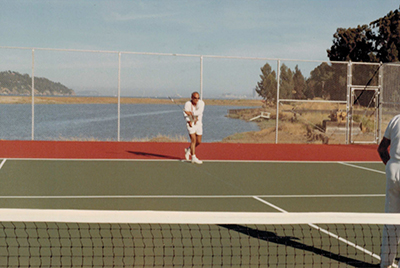
Harbor Point in the late ’60s with an undeveloped Strawberry Shores in the background.
The Harbor Point
Generations: 4
One family business that has benefited from good collaborative decision-making over the years is Harbor Point, the health club and apartment complex celebrating its 50th year on Mill Valley’s picturesque Strawberry Point. In fact, opening a health club to begin with was a pivot for brothers Ray and Marty Kaliski, who had been helping their father, Louis Kaliski, run his movie theater empire (which included Oakland’s Grand Lake) in 1963 when they discovered a foreclosure property with a hole in the ground and a view. Today that hole is an 80-degree saline pool and the view is enjoyed by members of a state-of-the-art fitness center and residents of a 220-unit apartment complex.
The idea of a place devoted to healthy living must have resonated for Ray, who earned the nickname “Frisky” when he set Oakland High School track records, and who proved he still deserved it when he lived to be a centenarian. Over the years, more record-setting athletes have enjoyed the club, including Andre Agassi and Steffi Graf; tennis legend Vic Seixas is a resident.
Ray’s son, Ray W. Kaliski, now runs the apartment complex with his spouse, Linda Nelson; his grandson Patrick Kaliski runs the health club. In 2005, the Kaliski’s added the Harbor Point Charitable Foundation, run by Patrick’s uncle, Robert Kaliski. Earlier this year, the family closed its restaurant and leased that part of the property to the owners of the Lighthouse Cafe in Sausalito and Corte Madera; it’s now the Lighthouse Bar & Grill.
All these changes were approved at quarterly board meetings that include the company’s accountant and attorney, Patrick says. “There were decisions made in the far — and recent — past that have benefited the business, like getting out of the movie theater business before the rise of television completely devastated it, purchasing a few pieces of prime property at a great price before a boom, and updating certain properties to keep them modern and desirable.”
5 Star Bail Bonds
Generations: 3
Hayden Hubbard was never squeamish about her father’s business. After all, growing up she wore the name of the company on the back of her basketball jersey, and she loved to help the ladies who ran Bogie’s Cafe next to the Marin Civic Center make dad Glen Hubbard’s lunch and carry it across the street to his homey office.
But until she joined Glen, 61, in the business, Hayden, now 31, never fully grasped what bail bonds are about: helping people at what is often the lowest point of their lives.
“It’s interesting to see the quality people who get caught up in these situations,” Hayden says. Sharing with her father the values of empathy and not passing judgment has helped her seamlessly take over much of the day-to-day business at 5 Star’s San Rafael office. Her aunt Lynn Simon runs another bail bonds company in Redwood City, with help from her daughter, and the two offices regularly collaborate.
Running a bail bonds company gave Glen, who played pro basketball in Europe, the flexibility to coach all three of his kids’ sports teams. But the family has to be flexible for their clients as well — like that time last Mother’s Day.
“We’re sitting there at the restaurant table and my aunt gets a call,” with questions about a bond she’d posted earlier, Hayden recalls. “We do have to keep our phones at the table.”
At various times, many members of the family have worked in the company, even Glen’s mother, Joan Perez. “Our clients say, ‘I remember the lady with the white hair,’ ” Hayden says. “She’s a spitfire of a lady but the most gentle person. She wouldn’t take any crap.”
Sabella & La Torre
Generations: 4
When a business is successful for 88 years, you approach change cautiously. When Gina LaRocca took over her father’s stake in the restaurant that was one of the first Fisherman’s Wharf businesses, she didn’t come in looking to shake things up.
“I feel more like the custodian of this historical thing happening,” says LaRocca, who since joining the family business at the beginning of this year is learning the ropes from a staff that includes both family members and those who feel like family, and from her co-owner, Tom La Torre.
LaRocca’s arrival was a big change for the business her great grandfather opened as a crab stand in 1927: she’s the first woman in the family to share the helm. After a successful career as a stylist at San Rafael’s Alessandro Salon, she took over for her father, Frank Lucian Sabella, after he developed Parkinson’s disease.
LaRocca told her father, “ ‘Dad, maybe it’s my turn.’ It took a little while for him to feel comfortable with it,” she adds.
Gina speaks respectfully of the generations that built the business and of her partner and cousin Tom La Torre, who first worked there in 1976 as a high school student and has been a co-owner for two decades. And respect is key to multigenerational success, Tom adds. “There will always be difference of opinions concerning business matters,” he says, “but at the same time, if you try hard enough you can usually find a middle ground that works for all parties.”
The hardest thing about running a family business where brothers, cousins and nephews are among your employees? Family weddings, Tom says. “Obviously everybody wants to attend the function, but somebody is going to have to work. You may feel guilty, but business is business.”
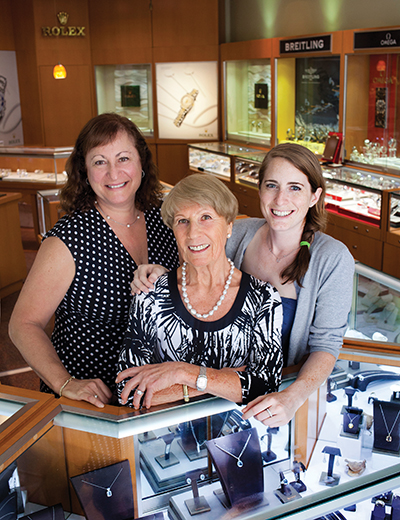
BARBARA RIES
Three generations make Julianna’s shine. From left to right: Judy White, Julianna Foris and Caitlyn White.
Julianna's Fine Jewelry
Generations: 3
Shoppers perusing engagement rings or Rolex watches sometimes catch three generations working in this boutique at once — Julianna Foris, who started the shop 30 years ago with her now-retired husband, Thomas Foris; their daughter Judy White; and her daughter Caitlyn White. The Forises were importers of wholesale chains that were sold in the 1980s when shopping mall pioneer Ernest Hahn invited them to open a jewelry store in The Village at Corte Madera.
Most of the other jewelry stores in the new mall were more upscale, Judy recalls. But over the years, with the addition of designer Jean-Louis Van Den Bosch (now a co-owner), the store became the embodiment of elegance it is today.
“The secret to a family business is try to keep emotions out of decisions, have a thick skin and don’t take things personally. Be logical about decisions and watch trends closely,” Judy says.

